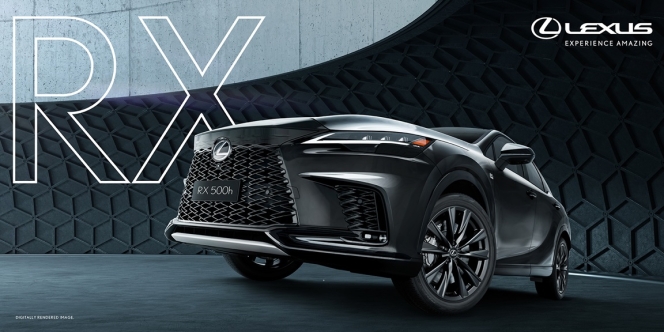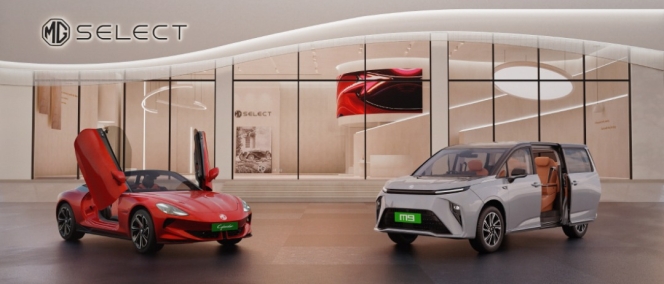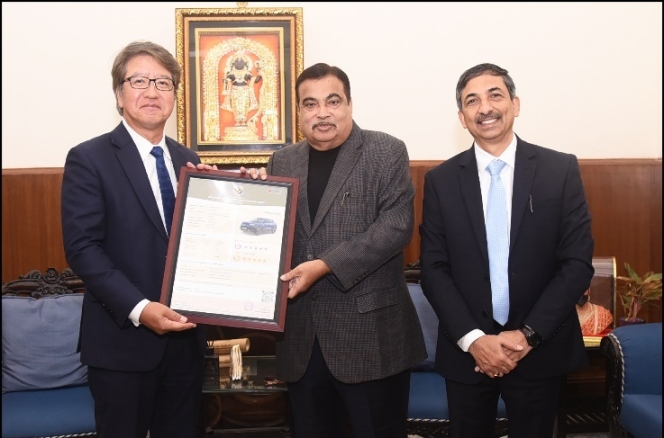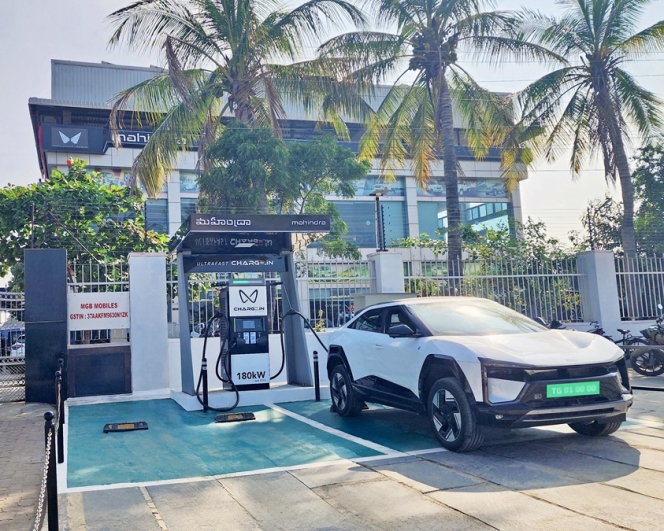
“When we launched the Kona Electric in 2018 as the world’s first fully-electric subcompact SUV, it represented a major step forward for affordable e-mobility,” says Andreas- Christoph Hofmann, Vice President Marketing and Product at Hyundai Motor Europe. “With the new Kona Electric, we’re showing that Hyundai is fully committed to zero-emissions driving, by providing our customers with enhanced driving assistance and safety features, making it an even more desirable package.”
Stylish Appearance
By combining a clean and sleek appearance with the protective and bold B-SUV body type of the Kona, it expresses its exceptional electric technology while being even more recognisable on the road. The front with the new-look closed grille features a pure and clean design. The new LED Daytime Running Lights further enhance the car’s wide stance. The front is complemented by an asymmetric charging port, a feature unique to the Kona Electric which makes a strong statement about driving electric.
New, sharper headlamps stretch around the side of the car. The high-tech headlamp inner bezel now incorporates multifaceted reflector (MFR) technology. The headlamps are connected to the painted wheel arch claddings, giving the new Kona Electric a distinctive and sophisticated look. Vertical air inlets in front of the wheel arch claddings enhance its aerodynamics, substantially reducing turbulence in the front wheelhouse area. Meanwhile, a functional air intake in the lower bumper is visually enhanced by horizontal satin accent bars, which give it a pronounced stance.
The rear bumper retains the accent bars to add value to the overall look of the car, while new horizontally-stretched rear lamps complement the pure appearance of the front.
The new Kona Electric is 25 millimetres longer than the previous version. This ensures it has a dynamic appearance combined with a strong visual stance.
Updated Interior
For the first time, the new Kona Electric is equipped with a 10.25- inch digital cluster, while an optional 10.25-inch AVN screen is carried over from the last update. The AVN unit incorporates multimedia and convenience features including Bluelink, Hyundai LIVE Services and Apple CarPlay and Android Auto, further democratising advanced connectivity for Hyundai drivers. Customers who select the eight-inch Display Audio system can wirelessly connect their smartphones to Apple CarPlay and Android Auto.
New Kona Electric customers can enjoy the new Bluelink upgrade, which allows them to control their car with their smartphone or voice to make their drive more convenient and enjoyable. Thanks to Remote Charging, new Kona Electric drivers can start and stop charging at the push of a button on their smartphone via the Bluelink app. During colder months, Remote Climate Control allows users to schedule a time that they would like to pre-heat their car electrically when connected to an external power source. As well as providing additional comfort to occupants, this also saves battery power that would otherwise be needed to heat the vehicle on the road.
The new ambient light technology illuminates the passenger and driver side footwell, emphasising the lifestyle character of the vehicle.
Driving Range
Like its predecessor, the new Kona Electric offers two different zero-emissions battery electric powertrains, with no compromises on performance. The long-range version with a 64 kWh battery features an electric motor which delivers maximum power of 204 PS (150 kW). The basic version has a battery capacity of 39.2 kWh, with the motor delivering 136 PS (100 kW). The long-range battery version provides a maximum speed of 167 km/h, with the standard-range battery version offering 155 km/h.
Both powertrain versions deliver 395 Nm of immediate torque, ensuring the new Kona Electric is fun-to-drive with full power available from the first second.
After tyre improvements on the 2020 model year update, the 64 kWh battery version offers a class-leading range of 300 miles (Worldwide Harmonised Light Vehicle Test Procedure - WLTP) on a single charge. Meanwhile, the 39.2 kWh model provides a range of up to 189 miles (WLTP).
The shift-by-wire system enables operation of the car simply by pressing buttons to switch driving modes. It also eliminates the routing space required for housing the mechanical linkages between a normal shifter and the transmission, providing additional storage space in the front of the car.
The Smart Adjustable Regenerative Braking system allows the car to automatically set the regenerative braking level, while paddle shifts behind the steering wheel enable the driver to adjust the intensity of the regenerative braking. The system recuperates additional energy when possible. Regenerative braking is maximised when keeping the left pedal held, allowing the driver to even bring the vehicle to a full stop – without the use of the brakes.
Charging the lithium-ion polymer battery from 10 to 80 per cent only takes about 47 minutes using a 100 kW direct current (DC) fast charger. It features an optional 10.5-kW three-phase on-board charger, allowing for significantly shorter charging times using public three-phase AC charging stations or with a private compatible wall box at home. Drivers also have the option of charging their car at a compatible regular household power socket using the ICCB-cable (in-cable control box).
Safety
Upgraded Hyundai SmartSense features that feature on the new Kona include Rear Cross-Traffic Collision- Avoidance Assist (RCCA) and Blind-Spot Collision-Avoidance Assist (BCA), which offer not just warnings to drivers, but also implement the brakes where necessary. RCCA works to avoid a collision when reversing, as the car’s sensors detect approaching vehicles from both sides, with the brakes applied if necessary. Meanwhile, BCA engages the car’s differential brakes to prevent an accident if another vehicle is detected near the rear corner and the driver attempts to change lanes.
Another feature new to this model is Leading Vehicle Departure Alert (LVDA), which alerts the driver if they do not react fast enough when the vehicle ahead of them starts moving. Further new safety features include Safe Exit Warning (SEW) and Rear Seat Alert (RSA). SEW warns passengers intending to exit the vehicle if it is not yet safe to do so. RSA is a door-checker feature that recognises if the rear doors have been opened prior to departing. When the drive is completed, the car alerts the driver if someone or something is in the back seat when they open the doors. Besides, the new car is also available with eCall, a feature which automatically alerts emergency services if the airbags are deployed, or the eCall button is pushed. (MT)
Lexus India Launches New RX350h Exquisite Grade At INR 8.99 Million
- By MT Bureau
- December 03, 2025

Japanese luxury brand Lexus India has introduced a new ‘Exquisite’ grade to its RX 350h line-up, strengthening the model’s presence in the luxury SUV segment.
The new RX 350h Exquisite grade starts at INR 8.99 million (ex-showroom), which goes up to INR 10.09 million (ex-showroom).
The RX 350h Exquisite grade features Lexus’ hybrid system, which combines a highly efficient 2.5-litre inline 4-cylinder engine and high-output motor. It includes a bipolar nickel-metal hydride battery with enhanced performance. On the inside, it gets 10-way power adjusted front seats, heated and ventilated seating for front & rear seats and ambient lighting.
The RX 500h F-SPORT grade is the only Performance Hybrid Electric Turbocharged Luxury SUV in India. The 2.4 L-T HEV on the RX 500h features a front unit integrating a 2.4-L turbocharged engine, motor, a 6-speed automatic transmission and an eAxle with a built-in high output motor driving the rear wheels. The RX 500h features Dynamic Rear-Wheel Steering and DIRECT4 technology for acceleration.
The RX features a Mark Levinson 21-speaker audio system and offers Lexus Safety System+ with Dynamic Radar Cruise Control, Cross Traffic Alert and Safe Exit Assist with Blind Spot Monitor.
Between January and November this year, the RX model recorded 12 percent growth, reflecting rising demand for luxury SUVs in the country. During the same period, SUVs contributed about 40 percent to Lexus India’s overall performance, underscoring the RX’s pivotal role in driving the brand’s momentum.
Hikaru Ikeuchi, President, Lexus India, said, ‘The Lexus RX represents our dedication to luxury, design, performance, and sustainable mobility. As the luxury SUV segment continues to grow, the introduction of the new Exquisite grade allows us to offer guests a wider range of options and features to choose from. This enhancement reflects our continued commitment to expanding our portfolio and elevating the Lexus experience in India, supported by advanced technology and a guest-first philosophy.”
MG SELECT Crosses 1,000 Sales And 15 Experience Centres
- By MT Bureau
- December 03, 2025

JSW MG Motor India has announced that its luxury retail channel, MG SELECT, has crossed a triple milestone: reaching 1,000-unit sales, inaugurating its 15th Experience Centre and maintaining the second position in India’s luxury EV market.
The network now encompasses 15 Experience Centres across 14 cities in India, reinforcing the brand's commitment to delivering an exclusive automotive retail journey. The recent inauguration of the 15th store in Jaipur further underscores the brand's ambition to redefine luxury mobility.
The milestone also highlighted sustained market demand for the select portfolio and is a key driver behind the brand’s 32 percent YTD growth in 2025.
The company claimed that the MG Cyberster, India's highest-selling sports car, has a 4–5 month waiting period, and the MG M9 - Presidential Limousine shows strong momentum in the luxury MPV segment. The MG Cyberster is available at an ex-showroom price of INR 7.49 million, while the MG M9 is available at an ex-showroom price of INR 6.99 million.
Anurag Mehrotra, Managing Director, JSW MG Motor India, said, "Our rise to become the second largest luxury EV brand in the country speaks to a singular belief. True luxury is felt in every touchpoint when precision, ambition and care move together. Through MG SELECT we have crafted an ownership world where innovation meets desire and where every interaction feels intentional. We are shaping the next era of electric mobility for India’s most discerning customers, with a commitment that is both bold and deeply personal.”
The MG SELECT Experience Centres are spaces for the brand's flagship vehicles. These venues provide an immersive, gallery-like setting, ensuring the display of these models is the focal point of the customer interaction. The Jaipur showroom, located at Tonk Road near Sanganer Flyover, exemplifies the MG SELECT philosophy of ‘Reimagining Luxury’, featuring spacious, serene, and technologically advanced environments that elevate the car buying journey.
Maruti Suzuki e Vitara Gets 5-Star Bharat NCAP Safety Rating
- By MT Bureau
- December 02, 2025

Maruti Suzuki India has been awarded a 5-star Bharat NCAP safety rating for its e Vitara, marking a moment for the company's electric vehicle strategy.
The e Vitara is built on Suzuki’s Heartect-e platform designed for electric vehicles to deliver strength, structural rigidity and advanced high voltage protection. The ‘Made-in-India, Made-for-the-World’ e Vitara is designed and tested for temperature conditions across the world, ensuring performance from as high as 60deg Celsius to as low as -30deg Celsius. The model is offered with 49 kWh and 61 kWh battery options.
Nitin Gadkari, Minister of Road Transport and Highways of India, said, “Congratulations to Maruti Suzuki for achieving 5-star Bharat NCAP in both adult and child occupant protection for their e Vitara. I am especially glad that Maruti Suzuki has shown real leadership in providing 7 airbags as a standard across all variants of the e Vitara.”
Hisashi Takeuchi, Managing Director & CEO, Maruti Suzuki India, said, “The 5-star Bharat NCAP rating for e Vitara, our first Battery Electric Vehicle, is a moment of immense pride for all of us at Maruti Suzuki. Using the Bharat NCAP 5-star rating, we will export the e Vitara to more than 100 countries of the world. Bharat NCAP’s globally benchmarked stringent vehicle test protocols have been a catalyst in empowering customers to make informed decisions. I thank the Minister Gadkari, the officials in his Ministry and test agencies for their rigorous efforts and commitment in shaping India’s journey towards safe mobility.”
The e VITARA’s body structure uses more than 60 percent ultra-high tensile and high-tensile strength steel. Its battery protection system incorporates a structural design with an energy-absorbing battery pack mounting structure.
Key safety features include 7 standard airbags (including the Driver's knee airbag), Level 2 ADAS (Automatic Emergency Braking, Lane Keep Assist, Adaptive Cruise Control), Hill Hold Control, ABS with EBD and Brake Assist, Electronic Stability Program (ESP) and a 360-degree Surround View Camera.
Mahindra Launches First Dealership-Based Ultrafast EV Charger In Anantapur
- By MT Bureau
- December 02, 2025

Mahindra has marked a major milestone in its nationwide electric vehicle (EV) infrastructure expansion with the inauguration of its first dealership-based ultrafast charger – a 180 kW Charge_IN station.
This is the first of many such installations planned across Mahindra dealerships, forming a key pillar of the company’s commitment to building India’s ultrafast charging network.
This initiative scales up Mahindra’s Charge_IN ecosystem, complementing the 250 highway fast-charging stations already announced. The new 180 kW ultrafast chargers will enable EV users to charge quickly and conveniently at strategically located dealerships across the country, with 24x7 on-ground support.






Comments (0)
ADD COMMENT